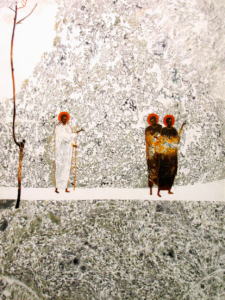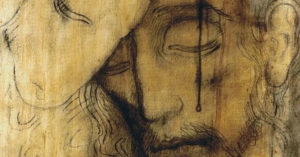In the main hallway of our house hangs a print of a painting by a Ukrainian artist named Ivanka Demchuck. It’s titled “The Road to Emmaus”, and it characterizes a scene from the story of its namesake. Nearing the very end of the Gospel of Luke, two disciples were walking together on the road to Emmaus when Jesus Himself approached them.
“They were talking with each other about everything that had happened. As they talked and discussed these things with each other, Jesus himself came up and walked along with them, but they were kept from recognizing him.” (Lk. 24:14-16)
I’ve always been captivated by this story, in large part because of how frequently I find myself identifying with these two disciples. How often do I go about life believing that I wouldn’t have any trouble recognizing where and how God is moving, only to miss His very presence?
As the story progresses Jesus even discusses His death and resurrection with the disciples, and still they are not aware that this stranger they’ve encountered is the Messiah resurrected.
But their lack of recognition wouldn’t persist forever. Their eyes are opened in a distinct moment that harkens back to Jesus’ final meal with his disciples (just two chapters earlier, in Luke 22).
“But they urged him strongly, “Stay with us, for it is nearly evening; the day is almost over.” So he went in to stay with them.
When he was at the table with them, he took bread, gave thanks, broke it, and began to give it to them. Then their eyes were opened and they recognized him, and he disappeared from their sight. They asked each other, “Were not our hearts burning within us while he talked with us on the road and opened the Scriptures to us?” (Lk. 24:29-32)

The Road to Emmaus, Ivanka Demchuck
I haven’t always understood the role of the Lord’s Supper in my own spiritual life or the life of the Church collectively. Frankly, there is a mystery to it that I think can be off-putting to many believers in the West, specifically, and in part for this reason, the Lord’s Supper didn’t hold as significant a role in discipleship for me as a child and early adult. It wasn’t until the last decade of my life that my understanding of this sacrament was challenged and deepened, and I began to long for a regular return to Christ’s table as a natural embodiment of what it meant to be on the journey of discipleship.
Maybe your experience is similar to mine. In the church tradition I was raised in, we paused four times a year to “take communion,” each time with reverence yet without much explanation beyond instruction to treat it as a moment of remembrance for Christ’s death for the salvation of the world. To be clear, the Eucharist meal very much is that. But it’s the echoes of that moment between Jesus and the disciples that take place at the end of the road to Emmaus that has me wondering if there is more to the meal that we may unintentionally have missed.
In the research and study that my willingness to wonder enabled, there are four distinct characteristics of the Eucharist that have brought a beautiful depth to my understanding of the sacrament in my own life, and in the life of the church:
1. The eucharist isn’t just an act of remembrance. It’s also a glimpse into the future.
For the disciples who broke bread with the risen Jesus in the story of the road to Emmaus, that shared act in community with each other would forever remind them of Jesus’ sacrificial love and the truth of His resurrection promise.
What does this mean for us? The Eucharist is not just a remembrance of past events (the Last Supper, Christ’s death, and His resurrection), but it is also a forward-looking celebration. When Christians gather at Christ’s table for the Eucharist, we can do so with hopeful anticipation for the fulfillment of God’s kingdom and the renewal of all things.
The Son of Man, who was poured out and broken for the forgiveness of sins, has defeated death. God’s great work of reconciliation with the world has begun. The Eucharist is a prelude to the promise of a restored relationship between God and God’s creation, and that includes each one of us.
2. It’s a meal meant to be celebrated as a community – for the sake of the community.
As much as each one of us needs to eat to be individually sustained, it’s our commitment to sharing life with each other – family, friends, neighbors, co-workers – over a meal that often leaves us reminiscing on the quality of a meal. The Lord’s Supper, as recorded in the Gospels, was not an individual experience but rather a communal meal that brought together the disciples of Jesus. As the early Church is formed and shaped in the epistles, it is Paul himself who extols the church in Corinth (1 Cor. 11) to take seriously the charge to ‘gather and eat together’ when celebrating the Lord’s Supper.
There is a richness that this realization has brought to my spiritual journey. It’s one thing to take seriously the gift that is Christ’s sacrifice symbolized by the bread and cup – and it’s another altogether to look across the table and wrestle with the beauty that is the unifying invitation that Christ has made. It’s given to those experiencing seasons of celebration and those stuck in mourning. In bounty and scarcity. In discouragement and hope.
The table transcends individuals, cultures, political ideologies, and denominational differences. Christ’s invitation exists for all of us.
3. Invitation to the Eucharist is an invitation to solidarity and co-suffering with Christ for the sake of the world.
In the Eucharist, there is a remembrance of Christ’s sufferings. Thus, when we are invited to eat at the table, we are invited to solidarity with the suffering Christ. This aspect of the meal is particularly poignant in the context of a world rife with injustice, oppression, and pain. Our messiah is one who intimately understands suffering and death, and He can be trusted with the sorrows that we carry.
In the same way, when we receive communion, we gather with others who may be experiencing their own season of suffering. When we join together with each other at Christ’s table, we are reminded of our willingness to walk in solidarity together. We leave from the table carrying with us the nourishment of a Savior whose promise is to one day make all things new again.
4. When we eat at Christ’s table, we receive gifts of transformation and renewal.
The Eucharist can also be seen as a moment of personal and communal renewal. It’s a time when individuals and communities renew their commitment to Christ and his teachings and are empowered to live out the gospel in their daily lives.
In the same way that the disciples were re-awakened to the movement of Christ in the world in Luke 24, the Lord’s Supper can serve as a centering and revitalizing practice for Christians in a world constantly competing for their attention. Just as we need to eat regularly in order to sustain life, the Eucharist, when received regularly, can be a source of strength for the Christian life.
As I reflect on the journey from my childhood understanding of the Lord’s Supper to a deeper, richer appreciation, I recognize the vastness of its mystery. I won’t pretend to know everything there is about the Eucharist; perhaps its depth and complexity are part of its beauty. It’s more than a ritual — it’s a spiritual practice that encompasses memory, hope, community, and transformation.
The Eucharist has become for me a pivotal point of connection. It’s where past and future, heaven and earth, sorrow and joy meet. In a world that often feels fragmented and disconnected, the Eucharist stands as a table where all are welcome, where barriers are broken down, and where we find our common humanity and hope for the future in Christ.



